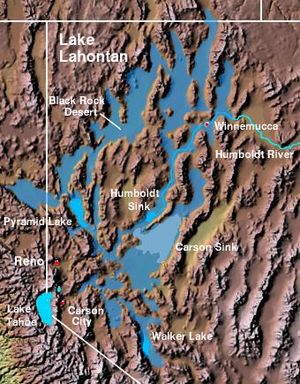Carson Sink facts for kids
Quick facts for kids Carson Sink |
|
|---|---|

View southeast across the Carson Sink from Topog Peak in the West Humboldt Range
|
|

The Carson Sink and the Lahontan Valley form the central portion of the lake bed of the prehistoric Lake Lahontan.
|
|
| Location | Lahontan Basin, Nevada |
| Coordinates | 39°52′40″N 118°20′50″W / 39.87778°N 118.34722°W |
| Area | 300 sq mi (780 km2) |
The Carson Sink is a large, flat, dry lakebed in Nevada, United States. It's like a giant, shallow bowl that used to be filled with water. Today, it's mostly a dry, dusty area called a playa.
This area was once the end point for the Carson River. Now, it gets water from special drainage canals. These canals are part of the Truckee-Carson Irrigation District. The southeastern part of the sink is a wetland. This means it's a marshy area with lots of water.
This wetland is very important for nature. It's part of the Fallon National Wildlife Refuge. It's also part of the Stillwater Wildlife Management Area. Many migrating waterfowl (birds like ducks and geese) stop here. They use it as a resting and feeding spot on their long journeys.
Contents
What is the Carson Sink?
The Carson Sink is a large, flat area in northeastern Nevada. It is a type of endorheic basin. This means it's a closed basin where water flows in but doesn't flow out to the ocean. Instead, the water either sinks into the ground or evaporates.
The sink is mostly a dry lakebed, also known as a playa. It covers about 300 square miles. This area is part of the larger Carson Desert.
Wildlife and Nature in the Sink
The southeastern edge of the Carson Sink is a vital wetland. This area is protected as part of the Fallon National Wildlife Refuge. It also includes the Stillwater Wildlife Management Area.
- Many types of waterfowl visit this area.
- It's a crucial stop for birds migrating across North America.
- The wetlands provide food and shelter for these birds.
Carson Sink and Lone Rock Areas
The Carson Sink also includes special working areas. These are used by the United States Navy. They are part of the Fallon Range Training Complex.
One important part is the Lone Rock working area. This area has a special place called Bravo-20. It is used for training combat aircraft.
Lone Rock's Significance
Lone Rock is a unique rock formation. It stands alone in the middle of the dry lakebed. This rock is very important to the Northern Paiute Native American tribe. They consider it a sacred place.
A Look Back in Time: History of Carson Sink
The Carson Sink has a long and interesting history. It was once a very deep part of a huge ancient lake.
Ancient Lake Lahontan
Thousands of years ago, during the Pleistocene Ice Age, a giant lake covered much of Nevada. This lake was called Lake Lahontan. The Carson Sink was one of the deepest parts of this massive lake. Today, the dry lakebed of Lake Lahontan is known as the Lahontan Basin.
Early Travelers and the Pony Express
During the California Gold Rush, many people traveled through this area. They used a route called the Carson Trail. This trail crossed a very dry area known as the Forty Mile Desert. Travelers were desperate to reach the first drinkable water on the Carson River.
In March 1860, a station for the Pony Express was built here. The Pony Express was a famous mail service. Riders on horseback carried mail across the country.
The Carson Sink Incident
In June 1952, two U.S. Air Force colonels were flying a B-25 bomber. They were flying from Hamilton Army Airfield to Colorado Springs. As they flew over the Carson Sink, they reported seeing something unusual. They said three unknown aircraft flew very close to their plane. These aircraft then quickly disappeared.
When they landed, the colonels reported what they saw. Air Defense Command headquarters told them there were no other planes in the area. The event was never fully explained. It is known as the Carson Sink UFO incident.
Flooding and Connection to Humboldt Sink
In 1984, there was a lot of heavy snowfall. This caused severe flooding in the area. To protect Interstate 80 and the town of Lovelock, a decision was made. The Nevada Department of Transportation broke a natural barrier. This barrier was between the Carson Sink and the Humboldt Sink.
This action connected the two sinks with water. They remained connected for three years, until 1987.
Images for kids

